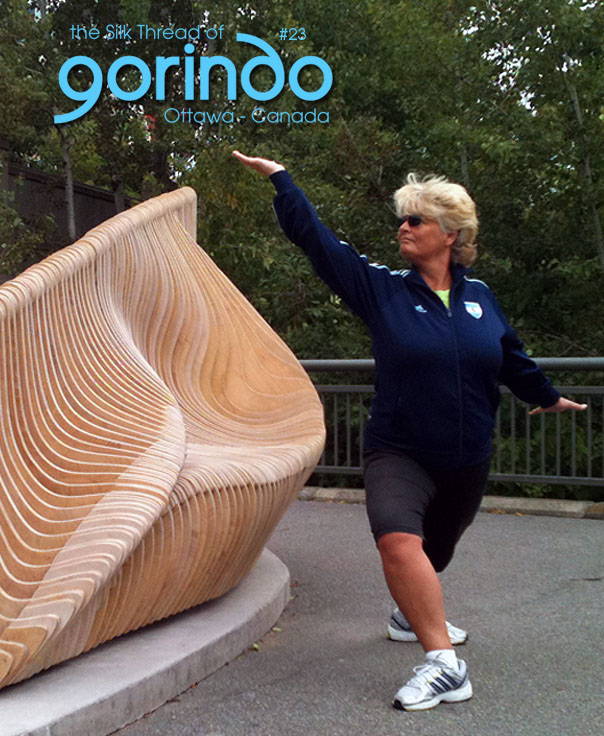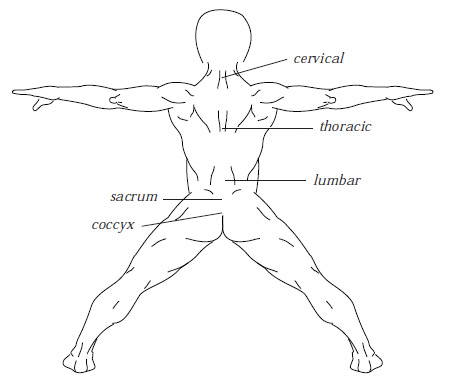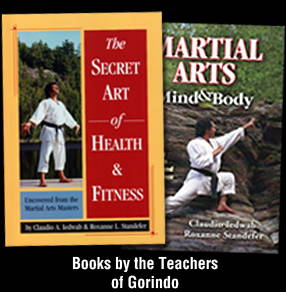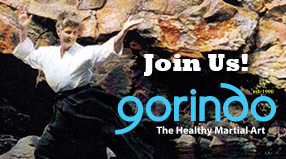
The Silk Thread of Gorindo - Ottawa - Canada
Issue 23
- Keeping in Line with Your Spine (Part 1)
- Kihon - Practicing Defences - Intro Level
Photo cover Roxanne Standefer Sensei & Kiito Shichidan Kata’ by ©2012 Claudio Iedwab
The wooden sculpture "Jetée" is the work of Toronto architects and artists Steven Beites and Christian Joakim, and it is located at the Ottawa end of the Alexandra Bridge.
Keeping in Line with Your Spine (Part 1)

The bony spine, and the musculature that allows it to function as it does, is one of several important components of the human body that we mostly ignore until something goes wrong. Then we hear or say: “My aching back!” or “My stiff neck!” and we pay heed only until the pain goes away. However, it is what we do with the spine all the rest of the time that leads to these conditions.
As soon as someone begins to discuss backs, posture, or breathing, we all tend to sit up straighter, pull our shoulders back, and squirm in our chairs. You may well have done so when you began to read this chapter. Although this a good reaction generally, it does indicates that we probably were not sitting or standing properly in the first place. Inactivity, together with poor body positioning does more damage to backs and necks as we age than any vigorous activity such as heavy lifting, tennis serves, or even minor traffic accidents ever could. Although these latter are responsible for many injuries, it is notable that most of the movements that “put the back out” tend to be simple ones like bending too quickly to pick up a sock, reaching over the bed to tuck in a sheet, or lifting a suitcase out of the trunk of your car. What we often fail to realize at these moments is that the fault lies not in the actions themselves, but the neglect to which we have subjected the spinal system for years, and in some cases, whole lifetimes.
Although there are those who have been born with curvatures or anomalies, and others whose injuries have produced conditions that require special care, most of us have allowed our spines to get out of line gradually. Over time, surrounding tissues and muscles have adapted and compensated. Even when told to sit up straight we may feel in line but in fact there may be subtle bends in the spine. This can cause an unnatural movement of components such as what occurs when your car wheels are out of alignment and the tires wear unevenly. As well, when we age, the spine’s natural shock absorbers begin to lose their elasticity, and a severe jolt, especially when vertebrae are twisted out of line, can cause them to fail or break down.
Fortunately, in recent years we have come to recognize, with the help of sports physicians and movement therapists, that these defects can be avoided, and in many cases reversed, by exercise, good posture, and more respect for the framework that supports the body.
The martial artist is already toiling in this field, working away on spinal alignment whether or not he or she has ever experienced back or neck pain before. In much the same way that the students of martial art are trained in the art of breathing, they learn the art of standing and sitting correctly from the very beginning of their practice. In order to move well, the martial artist requires a body that is well tuned and in good running order, one in which reflexes, balance, strength, flexibility, and intrinsic energy are responding in harmony. This is not possible without good alignment of the spine, head, and body.
Since so much martial art training is based on the disciplined and supervised execution of good technique, it offers an excellent opportunity for the development or repair of alignment. Learning the location of your center of gravity and how to lever or rotate the body around it, is practiced from the first day, and continues to a refined subtlety at advanced levels of training. From a health and fitness point of view, elegant technique and feats of balance and agility are all in aid of a relaxed, natural stance.
Developing self-awareness, or a kinesthetic sense of where your various body parts are and how they are moving in the execution of technique, is valuable both in and outside the dojo. A martial artist requires the ability to move quickly and change direction, but also to hold his ground in a stable stance when necessary. Although these demands may seem to be contradictory, they are in fact the principles of yin and yang at work; both are needed for balanced performance.
 In the previous chapter about breathing we touched upon the different ideal body images in the East compared with those of the West. The military bearing of the North American phys-ed student calls for broad shoulders, chest thrust out, and gut sucked in. A downward pointed triangle is formed and results in a perceived high center of gravity (a). Gymnastics and ballet also reflect this image of upward mobility. In traditional Eastern movements like the martial arts or dancing, the triangle is reversed, with a wide stable base and lower center of gravity located in the hara, in the abdomen (b). To further the analogy, one can see that a pyramid on its point is easily toppled, and while sitting on its base it cannot easily be dragged across the floor. The martial artist learns to stand and move in a way that takes advantage of these principles, building upon the stable foundation or spinning on the tip of the top as needed.
In the previous chapter about breathing we touched upon the different ideal body images in the East compared with those of the West. The military bearing of the North American phys-ed student calls for broad shoulders, chest thrust out, and gut sucked in. A downward pointed triangle is formed and results in a perceived high center of gravity (a). Gymnastics and ballet also reflect this image of upward mobility. In traditional Eastern movements like the martial arts or dancing, the triangle is reversed, with a wide stable base and lower center of gravity located in the hara, in the abdomen (b). To further the analogy, one can see that a pyramid on its point is easily toppled, and while sitting on its base it cannot easily be dragged across the floor. The martial artist learns to stand and move in a way that takes advantage of these principles, building upon the stable foundation or spinning on the tip of the top as needed.
While learning to breathe from the hara, the martial art student is also encouraged to “move from the hara,” feeling the weight low and with the upper body relaxed in motion. Techniques are then taught that allow the upper limbs and upper body to tense and brace upon impact against the rooted foundation (c).
Alternatively, being able to spin, turn aside or deflect an attack requires a similar awareness of ground, center of gravity, and rotational axis, but with a relaxed upper body.
The main rotational axis of the body is a line from the center of the head, passing through the body and hara and touching the ground at what we could call the center point of the stance. Keeping the upper body erect and the spine in line permits quick, balanced movement and the application of centrifugal force, using the extended limbs as striking, blocking, and deflecting weapons. Imagining the cross-sectional plane, the ability to swing like a pendulum in an axis that also hinges through the hara, is valuable for displacement movements and the utilization of the lower limbs for kicking or sweeping.
The martial artist begins to find his alignment by learning to stand properly in the “ready” or “natural” position with feet shoulder width apart, knees unlocked and back pulled up straight as if suspended from above the head, with the pelvis tucked slightly under. The feet should feel like they are alive and growing from the ground.
Many basic exercises can be performed in this stance so that the student learns the elements of vertical balance, such as how not to throw weight forward with a punch that might topple the body..
Excerpt from “The Secret Art of Health & Fitness – Uncovered from the Martial Arts Masters” by Claudio Iedwab & Roxanne Standefer
© 2012 Illustrations by Claudio Iedwab
- Keeping in Line with Your Spine (Part 1)
- Kihon - Practicing Defences - Intro Level
« Click the Subscribe link on the left




